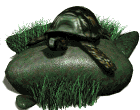





Four features were critical to reptiles' escape from water dependency:


Crocodiles and
alligators all live in or near water. The body plan includes a long snout.
Body temperature is regulated behaviorally (they are ectothermic). They show complex behavior,
as when the parents guard nests and assist hatchlings into the water.
Turtles possess a distinctive shell that offers protection while conserving water and body heat.
Turtle videos taken in the Storer Hall lobby.
Lizards and snakes



Lizards and snakes represent
about 95 percent of modern-day reptiles.
Most lizards are small-bodied insect eaters. Their most usual habitats are deserts and tropical forests.

You can listen to
an Iguana at the San Diego Zoo. You do not need to read the page itself.
Snakes are limbless but retain vestiges of hind limbs. They are excellent predators.
You can listen to a Python at the San Diego Zoo. You do not need to read the page itself.
Tuataras
Tuataras resemble lizards, but resemble amphibians in some aspects of their brain and in their way of walking. They are evolutionarily more ancient than lizards. They do not engage in sex until they are twenty years old. Only two species remain today. They live on islands off the shore of New Zealand.
REVIEW: �Reptiles moved fully onto land owing to _____ .
a. tough skin
b. internal fertilization
c. good kidneys
d. amniote eggs
e. all of the above�
REVIEW: �A four-chambered heart evolved first in _____ .�
REVIEW: The first group to exhibit an amniotic egg belonged to the��
PREVIOUS
NEXT
LECTURE 17 INDEX
MAIN INDEX